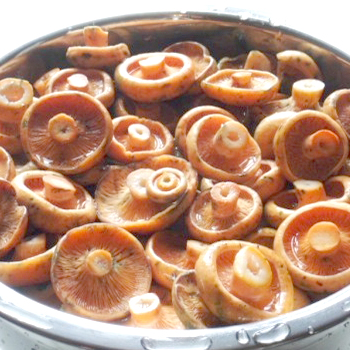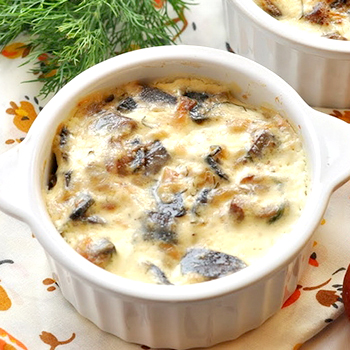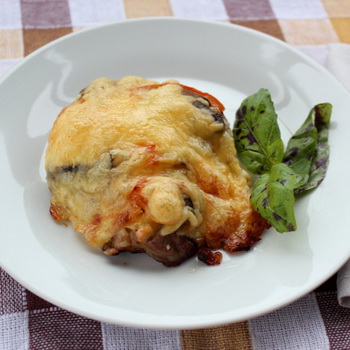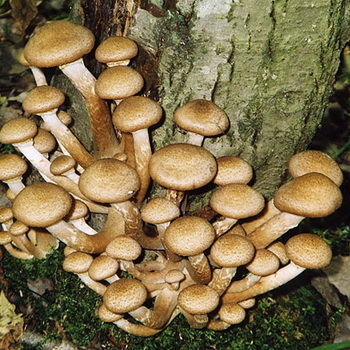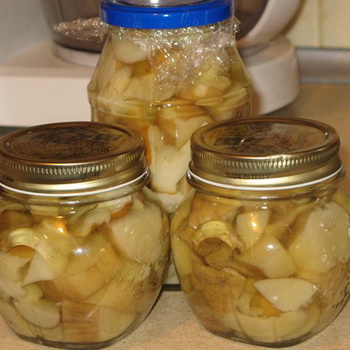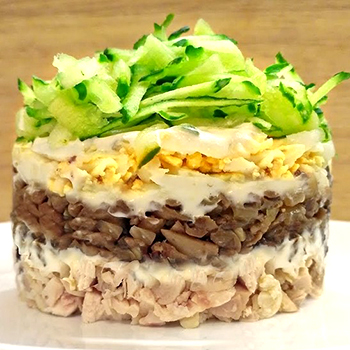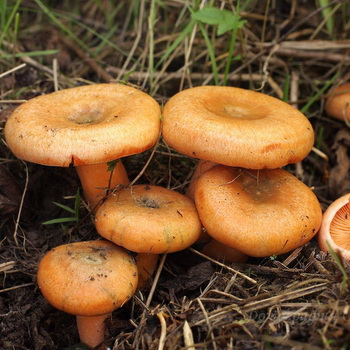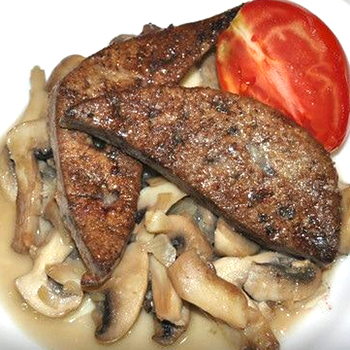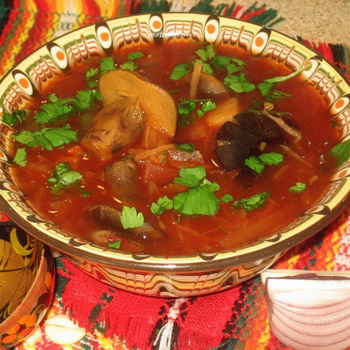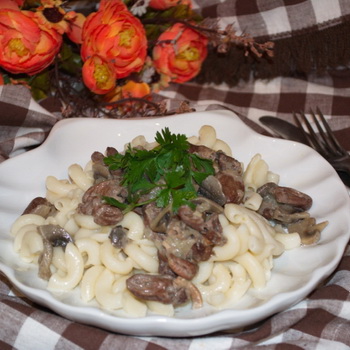Technology for growing porcini mushrooms in a personal plot: conditions and video, how to grow mycelium in the country
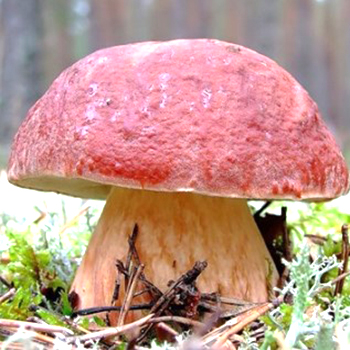 Despite their noble origin, boletus are ready to put up with changing growing conditions. Therefore, growing porcini mushrooms in the country is available to any gardener who has experience in cultivating mycelium of other forest gifts. If you do not have such a skill, then before growing porcini mushrooms on your personal plot, you need to thoroughly study the cultivation technology, and even better, first, practice on mushroom cultivation.
Despite their noble origin, boletus are ready to put up with changing growing conditions. Therefore, growing porcini mushrooms in the country is available to any gardener who has experience in cultivating mycelium of other forest gifts. If you do not have such a skill, then before growing porcini mushrooms on your personal plot, you need to thoroughly study the cultivation technology, and even better, first, practice on mushroom cultivation.
White mushroom, or boletus, refers to tubular mushrooms. It grows in sandy soils, but it can grow in fertile soil as well. More often found under birches, less often under oaks, prefers mature trees over 20 years old. It inhabits the temperate and subarctic zone throughout Eurasia. Fruiting from June to October.

Check out this material and watch a video on how to grow porcini mushrooms in the open field in the country. After that, you can start cultivating.
What porcini mushrooms look like
The cap of the porcini mushroom is painted in various colors: yellow, brown, brown, red, purple, gray-brown. The color depends on the place where the fungus grows. Also, the hat can be uneven in color: often at the edges it is much lighter than in the center. The cap is tubular, cushion-shaped, it grows up to 20 cm in diameter.

The tubules are white at first, then turn yellowish-greenish or yellowish-olive. The leg is thick, thickened at the bottom, with a mesh pattern. Sometimes it is present only in the upper part of the leg. Usually its color coincides with the color of the cap, only slightly lighter. The pulp of the fruiting body is white, dense, odorless and with a nutty taste. In the place of the cut, the color does not change.
Check out what the porcini mushrooms look like in these photos:



White mushroom is appreciated not only for its taste. It is also able to stimulate the secretion of digestive juices. It should be noted that boletus differs markedly from other mushrooms in terms of nutrient content. Despite all its positive qualities, it is noticeably inferior to the boletus in the presence of proteins, and the chanterelle and morel - in the content of such trace elements as phosphorus and potassium. It should also be noted that the assimilation of protein after drying the porcini mushroom increases by 80%. Dried mushroom has its own special aroma, so its powder is often used as a seasoning for various dishes.
The porcini mushroom also has other useful qualities: tonic, anti-infectious, wound-healing, antitumor. Thanks to the lecithin contained in the mushroom, it is useful for anemia and atherosclerosis, liver and kidney diseases, and eye pathologies. It has a positive effect on the immune system, helps to break down glycogens and fats, and remove excess cholesterol from the body.
These mushrooms, growing under different trees, have different cap colors. The darkest boletus grows under the spruce, and those growing under the pine have a beautiful red-brown cap.
The following describes in detail how to grow porcini mushrooms at their summer cottage.
How to grow porcini mushrooms: preparing open ground
Boletus has always been considered the king of all mushrooms. Before growing porcini mushrooms in the country, remember that they belong to the mycorrhizal group, that is, they grow in symbiosis with tree roots. Therefore, the conditions for growing porcini mushrooms should be similar to the conditions under which they live in the wild.

Mushrooms grow only under birch, aspen, spruce, beech, oak. They love moderately humid and light meadows, but not under the open rays of the sun. Boletus will not grow in dark places. Also, the porcini mushroom does not tolerate the neighborhood with some herbs, for example, with ferns and hoofs.All of these factors should be taken into account when choosing a place to cultivate a given mushroom.
If you have appropriate trees in your garden, then it is quite easy to establish the cultivation of a porcini mushroom on an industrial scale. In artificial conditions, without trees, no one has yet managed to grow this mushroom.
To grow porcini mushrooms outdoors, you need to take care of the preparation of the beds. To do this, a pit 2 m wide and 30 cm deep is dug on the selected site. It is filled with a special mixture that is prepared in advance. Fallen oak leaves are harvested in spring and mixed with rotten oak wood and pure horse manure. Both oak wood and horse manure must be added to the leaves in a ratio of 5% of their volume. First, the leaves are put in a layer of about 20 cm, a little horse manure and rotten wood are poured and watered with a 1% solution of ammonium nitrate. Then exactly the same new layer is laid. In this way, several layers are performed. After 7-10 days, the mixture should warm up to 40 ° C. At this moment, it must be mixed so that it becomes a homogeneous mass. After a month, the mixture is ready and it is placed in a pit in the form of layers 10–12 cm thick. In accordance with the correct technology for growing porcini mushrooms, each layer of the mixture is sprinkled with garden soil 6–8 cm thick. The entire thickness of the bed is about 50 cm. In the middle it is made higher so that water rolls off it.
The following describes how to grow mycelium of porcini mushrooms in the country.
Sowing mycelium and caring for porcini mushrooms

There are several ways to grow porcini mycelium. In the first method, overripe boletus is collected and poured with rainwater in a wooden dish. This mixture is left for a day. Then mix well and filter through a rare cloth. As a result of this procedure, a lot of white fungus spores remain in the water. They sink to the bottom. For their germination, you can add a little baker's yeast to the water. Then carefully remove the foam with a spoon and drain the upper part of the clear liquid, and place the rest of the solution with spores in the light. You can drain the remaining liquids from different containers into one. After a week, the upper part of the clear liquid is carefully drained, and the settled suspension is poured into bottles and stored in the refrigerator. This suspension can be used for a whole year, but it is better to use it during the first month, since it is at this time that the spores retain their viability. This mixture is poured over the prepared bed, and the top layer of the soil is first removed. You can also sprinkle the mixture around selected trees. Before growing the mycelium of porcini mushrooms, you first need to carefully remove the soil layer without damaging the tree roots. This is done to expose the roots of the trees. Then pour the slurry over them and cover them with earth again. Pour the suspension at the rate of 400 g for every 30 cm. After that, the soil should be watered abundantly with 4–5 buckets of water.
This video tells in detail about growing mycelium of porcini mushrooms in the first way:
In the second method, the mycelium is harvested in places where porcini mushrooms grow. For this, layers of soil with dimensions of 20 X 30 cm and a thickness of 10-15 cm are cut out around the mushroom. Then they are cut into several parts and planted in a garden bed or in a chosen place so that there is a layer of earth 5-7 cm thick above them. slightly moisten and cover with leaves and shields so that they are always moist.
Ceps should be sown under the same trees under which the planting material was taken. It has been noticed that boletus grow better under trees that are 15–25 years old.
You can sow mycelium in another way. For this, the overripe caps of porcini mushrooms are cut into small pieces and mixed with a small amount of soil. Then moisturize it a little. You can also sow slightly dried mushroom caps. They are laid out on the garden bed and watered with water.After 5–6 days they are removed - the spores have already penetrated into the soil together with water. You can put the pieces of the cap under the top layer of the soil. Sowing mycelium is best in September.
This video shows you how to grow porcini mushrooms in the second way:
When leaving, the mycelium should not be poured too much with water, it may die; but in dry autumn it should be moistened with a watering can or spray. Growing and caring for mycelium consists in periodic watering during dry summers. Watering is desirable early in the morning. There is no need to apply mineral fertilizers. Single mushrooms appear the next year after planting, and a good harvest is removed 2 years after sowing. You can get a bucket of crops under one tree. When collecting mushrooms, they should be carefully cut off, leaving the remains of the leg, so as not to damage the mycelium.

